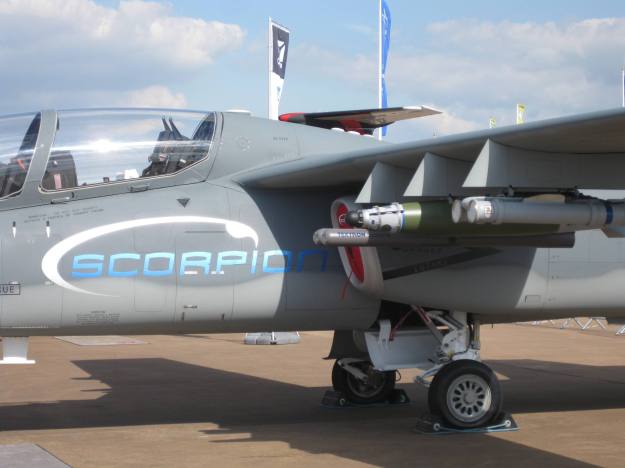The Scorpion Intelligence, Surveillance and Reconnaissance (ISR) / Strike aircraft is being developed by Textron AirLand, a joint venture between Textron and AirLand Enterprises.
The aircraft is capable of performing air defence, irregular warfare, border patrol, maritime security, disaster relief and counter-drug missions.
The development of the Scorpion aircraft was commenced in January 2012, with the objective of producing the most economical jet-powered light attack aircraft in the world.
First production Scorpion test flown: Here
 Image: Textron
Image: Textron
Excerpt
Conducted from McConnell AFB in Kansas on 22 December, the 1h 42min first flight “verified the avionics and aerodynamic performance, as well as a number of aircraft systems”, the Textron company says. Registered as N530TX, the jet “performed extremely well”, it adds.
Design improvements introduced with the new aircraft include a simplified landing gear, enhanced aft horizontal stabiliser and an additional 4˚ of sweep to its wing.
In the cockpit, the Scorpion gets a new head-up display, hands-on-throttle-and-stick controls and a Garmin G3000-based avionics suite. “The newly configured avionics system features a large, high-definition display complemented by touch-screen controllers and provides more mission capability in the forward cockpit position, additional navigation capability in the rear cockpit position and overall weight savings,” the airframer says.
US Air Force to evaluate improved Scorpion jet: Here
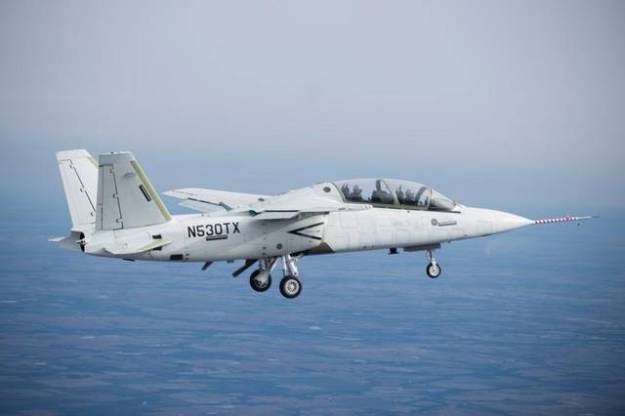
Excerpt
Changes to the production-conforming Scorpion included 4 degrees of sweep to the wings, an enhanced aft horizontal stabilizer and a simplified landing gear design.
Officials from Textron AirLand, a unit of Textron Inc., said during the test flight that they verified the Scorpion’s newly configured Garmin G3000 avionics and aerodynamic performance as well as a number of other aircraft systems.
Now, the revamped twin-engine, multimission jet will undergo an assessment by the Air Force Airworthiness Office.
Light ISR: The Air Force’s next experiment?: Here
Excerpt
The Air Force is considering whether to press forward with a demonstration of inexpensive, off-the-shelf light intelligence, surveillance and reconnaissance (ISR) aircraft that could complement a potential light attack plane buy.
The service completed a demonstration of four light attack planes at Holloman Air Force Base, New Mexico, in August. During the demonstration, Textron’s Scorpion aircraft caught the attention of Gen. Mike Holmes, head of Air Combat command, because its modular design allows for a wide package of sensors.
As a result, Holmes said, some in the service are now intrigued by the idea of hosting a similar demonstration focused on ISR capabilities.
“If you look at some of the airplanes we flew, there are airplanes that have kind of been built with great big internal bays where you could carry a whole variety of sensors, so it’s an intriguing possibility for Scorpion,” Holmes told reporters during a Sept. 18 roundtable at the Air Force Association’s annual conference.
Saudi Arabia considering Scorpion deal: Textron chief: Here
Excerpt
Saudi Arabia is considering acquiring the Textron AirLand Scorpion light attack aircraft, with initial discussions under way.
Scott Donnelly, chief executive of parent company Textron, says Riyadh is one of a number of customers it is in talks with over the developmental aircraft.
The recent arms deal between the USA and Saudi Arabia includes $2 billion for “light close air support” aircraft. However, no details on the type or delivery dates have been disclosed.
Cautioning that its talks with Riyadh are at an “early” stage, Donnelly, speaking on a second-quarter results call, added: “There are certainly a number of things that we are looking at, but we think that now the performance envelope, the capability of what Scorpion can do makes it a very viable product for their requirements. But it’s still in its formative stages, I would say.”
Saudi Arabia Puts Textron’s Scorpion Light Attack Jet Through Its Paces: Here
Excerpt
As Saudi Arabia continues its multi-billion dollar international arms shopping spree, it appears to have begun evaluating Textron AirLand’s Scorpion light attack jet. The firm has previously said that the Kingdom is interested in the aircraft, but growing American political opposition to its brutal and protracted intervention in Yemen might slow or scuttle actual purchases.
Textron Divisions Pair Scorpion Jet With Drone Control Capability


The Scorpion aircraft features an all-composite airframe and structure powered by twin turbofan engines. Its fuselage integrates a tandem cockpit, retractable sensor package, internal payload bay and external mounts for precision and non-precision munitions. The corrosion-resistant airframe offers 20,000 hours of service life.

The aircraft is designed to integrate globally-available commercial components for reducing the total cost of ownership. The modular architecture of the aircraft allows for future integration of various sensors and weapon systems with reduced integration costs.
The internal payload bay is designed to deliver critical operational flexibility, by quickly accepting new payloads for different operational requirements. It can house various modules of sensors, fuel and communications in desirable combination to achieve high performance during a wide range of missions.
Scorpion Strike / ISR aircraft cockpit and avionics

The Scorpion aircraft accommodates two pilots in tandem layout. The two cockpits are equipped with advanced multifunction colour displays, providing the details of flight characteristics, aircraft operation, navigation and armament data.
The avionics suite integrates inherent Flight Management System (FMS), Class-B Terrain Awareness and Warning System (TAWS), engine indication and crew alerting system (EICAS), dual Air Data, Attitude and Heading Reference Systems (ADAHRS), dual GPS/Satellite Based Augmentation Systems (SBAS) and integrated moving maps.
The nigh-vision compatible cockpit also offers instrumentation for weather radar control, display of external video and digital flight data recording.
Scorpion jet to get BAE Systems LiteHUD display: Here
LiteHUD HeadUp Display
 Image: baesystems.com
Image: baesystems.com
Featuring Patented Optical Waveguide technology
LiteHUD® is a small and compact Head-Up Display (HUD), offering space and weight advantages paired with the latest optical waveguide technology. Its modular and lightweight design improves flight safety, reducing fatigue and increasing situational awareness day or night. Providing seamless operation with night vision goggles (NVGs), LiteHUD® allows for incremental capability upgrades with minimal impact to helmet and aircraft installation.
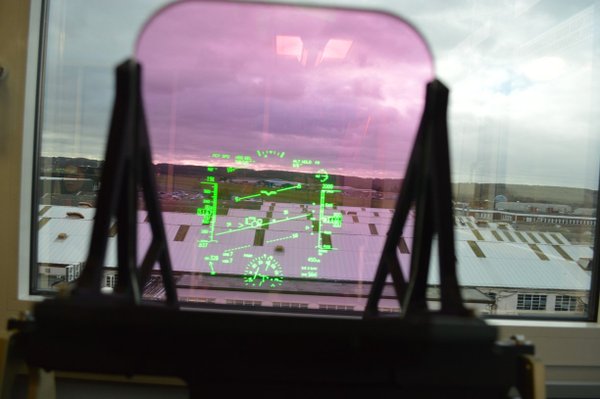 Image RAeSTimR
Image RAeSTimR
The benefits of LiteHUD
- 60% smaller and 50% lighter than a conventional HUD, integrates easily into both existing and future cockpits
- Incorporates significantly larger eye motion box, increasing pilot comfort
- High-resolution navigation and sensor imagery displayed under all flight conditions
Source baesystems.com
 New glass cockpit – aviationphotodigest.com
New glass cockpit – aviationphotodigest.com
Garmin G3000 Avionics suite
Fingertip Control Meets Integrated Flight Deck
- Touchscreen control to light turbine aircraft
- Wide-format WXGA displays
- Most intuitive pilot interface available in this class of avionics
- Synthetic Vision Technology (SVT™)
- NextGen/SESAR growth provisions
Source garmin.com
Textron’s Scorpion jet completes first weapons exercise: Here
Excerpt
Weapon systems, sensors and radars on the Scorpion aircraft

The Scorpion ISR / Strike aircraft can be armed with a range of scaled munitions for indulgent military and homeland security environments.
The aircraft can carry an array of weapons systems on its external hard points under the wings. Three under-wing hard points on either side of the fuselage can hold precision guided munitions (PGMs) and general purpose munitions.
The Scorpion can be integrated with a variety of sensors, electro-optical / infrared devices and communication packages to perform various missions.
The aircraft will be offered with dedicated mission sensor systems, for conducting boarder security, maritime patrol, irregular warfare support, law enforcement, counter narcotics and humanitarian assistance / disaster response missions.
Scorpion Light Attack Jet During Weapons Separation Testing: Here
 theaviationist.com
theaviationist.com
Weapons such as the HMP-400 .50 Cal guns and LAU-131A/A rocket launcher were monitored for hot gas ingestion into the intakes. Operational modes were tested and wiring configurations were evaluated.
Weapons tested included:
- LAU-131A/A 2.75” unguided/guided rocket launcher
- HMP-400 .50 Cal machine gun pods, (two flights with single and simultaneous firing)
- GBU-12 Paveway II 500 lb. bombs
- BDU-50 (500 lb. practice bomb)
LAU-131 seven-tube rocket launchers

The LAU-131/A is a 7-round 2.75-inch (70 mm) rocket launcher, primarily used by the U.S. Air Force.
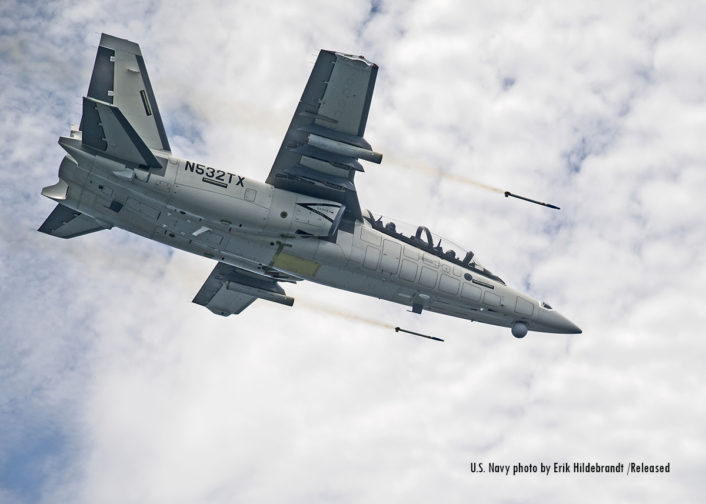 Textron Scorpion fires 2.75″ Hydra-70 rockets during recent weapons trials at NAS Patuxent River, MD. The Textron team achieved 100% mission completion rate during weapons system testing. 5 different configurations (LAU-131, HMP-440 Gun pods, GBU-12) were tested over 5 days, with the tests concluding 4 days early. – theaviationist.com
Textron Scorpion fires 2.75″ Hydra-70 rockets during recent weapons trials at NAS Patuxent River, MD. The Textron team achieved 100% mission completion rate during weapons system testing. 5 different configurations (LAU-131, HMP-440 Gun pods, GBU-12) were tested over 5 days, with the tests concluding 4 days early. – theaviationist.com
HMP Machine gun pods

The HMP pods are fitted with the 12.7mm M3P heavy machine gun and carry either 250 or 400 rounds of ammunition. The M3P has a rate of fire of about 1.075 rpm and may use any type of 12.7mm ammunition. The effective range is 3 km versus area targets and 1 km against single vehicles.
The HMP pods are fitted with a 12.7mm M3P heavy machine gun. Three versions are available. The designation HMP is followed by the number of rounds it carries and if it is fitted with a links collector (LC) or links and case collector (LCC).
HMP-400 LC: HMP model with 400 round capacity and links collector. It is identified by its squared rounded nose cone.
| Type | Gun pod |
| Platform | Aircraft, helicopters |
| Length | 2.12 m |
| Diameter | 0.41 m |
| Weight | 138 kg loaded |
| Armament | 12.7mm M3P machine gun with 400 rounds |
| Remarks | Mach 0.70 maximum speed, 355 mm lug spacing |
HMP-400 LCC: HMP-400 model with links and case collector. The case collector is located in the squared bulge below the pod.
| Type | Gun pod |
| Platform | Aircraft, helicopters |
| Length | 2.12 m |
| Diameter | 0.41 m wide, 0.45 m tall |
| Weight | 138 kg loaded |
| Armament | 12.7mm M3P machine gun with 400 rounds |
| Remarks | Mach 0.75 maximum speed, 355 mm lug spacing |
Source weaponsystems.net
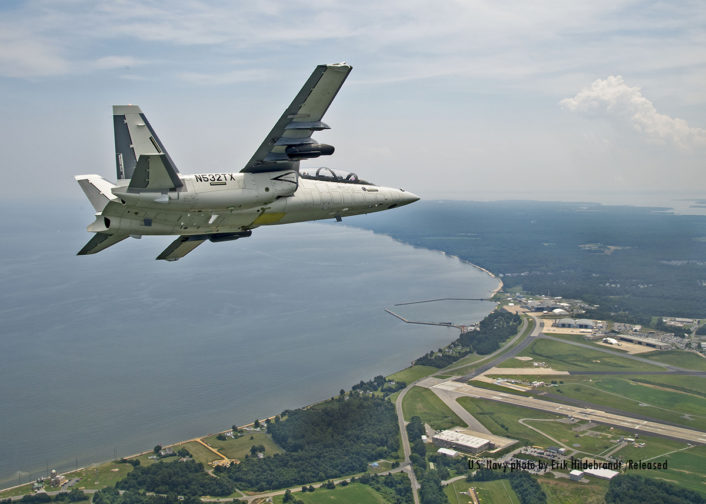 Textron Scorpion with HMP-400 gun pods overflies NAS Patuxent River during recent weapons trials. The TEXTRON team achieved 100% mission completion rate during weapons system testing. 5 different configurations (LAU-131, HMP-400 Gun pods, GBU-12) were tested over 5 days, with the tests concluding 4 days early. – theaviationist.com
Textron Scorpion with HMP-400 gun pods overflies NAS Patuxent River during recent weapons trials. The TEXTRON team achieved 100% mission completion rate during weapons system testing. 5 different configurations (LAU-131, HMP-400 Gun pods, GBU-12) were tested over 5 days, with the tests concluding 4 days early. – theaviationist.com
GBU-12 Paveway II

Despite the original contractor for the Paveway II LGB bomb was Raytheon, Lockheed-Martin began assembly Paveway II laser guidance kits in the early years of the 21st century in support of the Global War on Terror and the military campaigns in Iraq (Iraqi Freedom 2003-20??) and Afghanistan (Enduring Freedom 2001). As of September 2005, Lockheed Martin had delivered more than 25,000 guidance kits for the GBU-10, GBU-12 and GBU-16 guided-precision bombs.
Dimensions
Diameter: 270 millimeter (10.6 inch)
Length: 3.33 meter (131 inch)
Wingspan: 1.32 meter (52 inch)
Performance
CEP: 9 meter
Max Range: 14,800 meter (7.99 nautical mile)
Weight
Warhead: 87 kilogram (192 pound)
Weight: 277 kilogram (611 pound)
Source: deagel.com
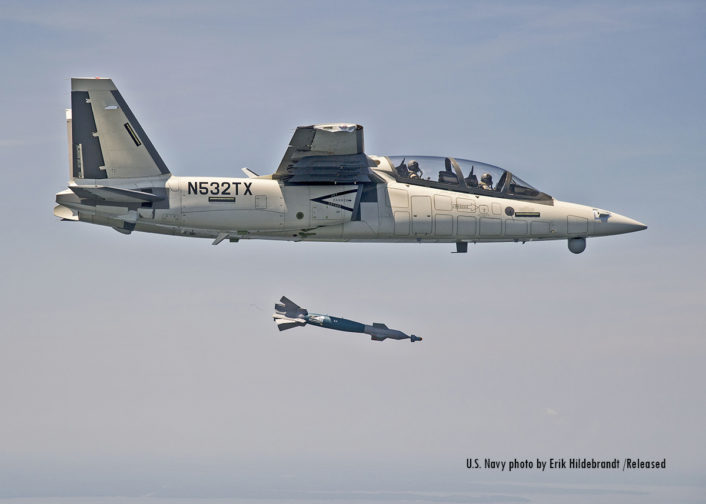 Textron Scorpion drops a 500 lb GBU-12 Paveway II during recent weapons trials at NAS Patuxent River, MD. The Textron team achieved 100% mission completion rate during weapons system testing. 5 different configurations (LAU-131, HMP-400 Gun pods, GBU-12) were tested over 5 days, with the tests concluding 4 days early. – theaviationist.com
Textron Scorpion drops a 500 lb GBU-12 Paveway II during recent weapons trials at NAS Patuxent River, MD. The Textron team achieved 100% mission completion rate during weapons system testing. 5 different configurations (LAU-131, HMP-400 Gun pods, GBU-12) were tested over 5 days, with the tests concluding 4 days early. – theaviationist.com
Scorpion Selected for ASDOT Proposal: Here
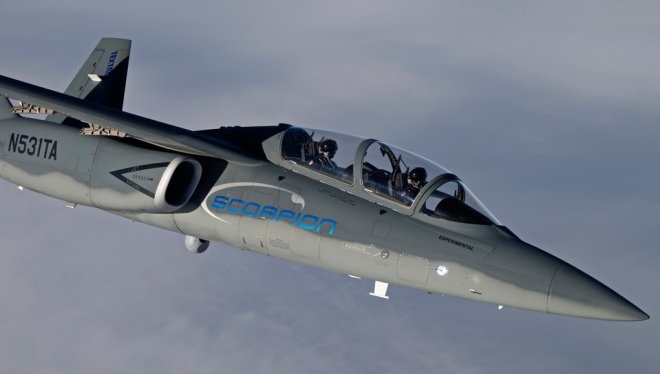
Excerpt
The Textron AirLand Scorpion has been selected by QinetiQ and Thales to provide a large proportion of the platform capabilities for their planned ASDOT bid (ASDOT is the UK Ministry of Defence’s Air Support to Defence Operational Training program). The three company CEOs involved signed a memorandum of understanding at Farnborough yesterday to launch the bid.
An ASDOT contract is due to be awarded in September 2018, with delivery of the service to run for 15 years starting in January 2020. The program aims to deliver a new training capability to meet the needs of a modern force, with increasing emphasis on a mix of live flying with simulation and synthetics. As such, ASDOT is closely linked with the Defence Operational Training Capability—Air (DOTC—Air) program, which is primarily concerned with synthetic training.
Air Force to Certify Scorpion Jet, Broadening Its International Appeal: HERE
Thales RDY-3 multi-mode radar

The RDY-3 features all the advanced functions required on a multirole aircraft of the 21st century.
The Air-to-Air function with its advanced automatic mode management reduces pilot workload – search domain management, ranking and sorting of highest priority targets – and allows better tactical situation assessment and mission efficiency.
Multiple scanning patterns as well as angular domain and scanning speed are automatically managed by the radar
Advanced Combat modes with fast and automatic target acquisition and tracking adapted to hard target manœuvres at short range; high quality of target designation associated to simultaneous multi-tracking and multi-shoot capability.
The Air-to-Surface modes adapted to various missions: Navigation, Surveillance, Target, Acquisition, Very-Low Level penetration.
The reference in its category
• Lightweight and multifunction radar
• Modular design
• Adaptable to a wide range of combat aircraft

OPERATIONAL BENEFITS
Air-to-Air Function
- Very long range, all aspect, look-up / look-down detection
- Automatic waveform management and antenna scanning
- Multi-target automatic lock-on and TWS
- Simultaneous multi-target fire control
- Single Target Track
- Combat modes
- IFF interrogator capabiliy
Air-to-Ground Function RDY-3 provides all the modes required for day and night, all-weather operations:
- High Resolution Mapping spotlight SAR (picture)
- Terrain Avoidance (Contour Mapping for Blind Penetration)
- Moving Target Indication and Tracking
- Air-to-Ground Ranging
- Freeze / Silence
Air-to-Sea Function RDY-3 provides all the modes required for BVR attack of surface ships:
- Long-range detection
- Multi-Target TWS
- Target RCS assessment
- STT
- ISAR (option)
Others • Easy Air-to-Surface modes transitions
RDY-3 KEY FEATURES
- Modular design
- Light weight:
- Low power consumption: 3.5 kVA
- Different antenna sizes available
- High average transmitted power: 400 W
- Up-to-date signal processing technologies
- COTS components for obsolescence protection
- 1553 Bus
- Advanced ECCM features
- Very Low False Alarm Rate
- Flexibility and growth potential
- Efficient BITE and maintenance concept for reduced manpower and life cycle cost

Source thalesgroup.com

L-3 WESCAM’s MX-15D sensor suite

MX-15D
Ideal for: Medium-altitude; Covert Intelligence, Surveillance & Reconnaissance (ISR),
Armed Reconnaissance, CSAR, Target Designation missions
Installations: Fixed-wing, Rotary-wing, UAV, Aerostat
Features & Benefits
Multi-Sensor Imaging/Lasing Payload Options:
- Currently supports up to ten sensors simultaneously
- Superior HD imaging resolution from Electro-Optical (EO) and Infrared (IR) cameras
- Short-wave IR imaging
- Laser rangefinder/designator
- 3 laser illuminator divergence options
- Hyper-spectral imaging blends matched images from multiple sensors, uncovering greater detail in each frame
Enhanced Local Area Processing (ELAP):
- Real-time image enhancement for EO day, EO night & IR
Consistent Targeting Accuracy:
- Full-laser stabilization minimizes spot jitter
- Internal isolator minimizes vibration-induced boresight shifts
- Operationally-proven precision target designation
High-Performance IMU & MX-GEO Software Suite:
- IMU & MX-GEO work to create accurate target location
- MX-GEO automatically aligns to the aircraft
- Robust automatic image focus
Uncompromised Stabilization:
- Four-axis gimbal with internal IMU
- All payloads are fully-stabilized
MX-Series Commonality:
- Common operator interfaces and Hand Controller Units (HCUs)
- Simplified interchangeability
- Efficiencies in support and technology enhancements

WESCAM Kinetic™
WESCAM Kinetic is a suite of powerful situational awareness and target detection capabilities that easily integrate with WESCAM’s MX-Series of imaging sensors. The Suite includes:
Kinetic™ ISR – Intelligence, Surveillance and Reconnaissance
A map-based sensor management package providing operators with advances sensor control from an intuitive, user-friendly interface
Kinetic™ MTI – Moving Target Indicator
A moving target indicator tool that detects moving objects in a screen
Kinetic™ Speed
A powerful tool used to indicate the speed at which a target is moving on the ground or in the water
Source wescam.com
 Textron AirLand Scorpion camera dome seen during the Royal International Air Tattoo at RAF Fairford on July 18, 2015 in Gloucestershire, England. The Royal International Air Tattoo (RIAT) is the world’s largest military air show, July 19, 2015 Licence
Textron AirLand Scorpion camera dome seen during the Royal International Air Tattoo at RAF Fairford on July 18, 2015 in Gloucestershire, England. The Royal International Air Tattoo (RIAT) is the world’s largest military air show, July 19, 2015 Licence
Thales successfully integrates I-Master radar on Textron’s Scorpion light attack and ISR aircraft: Here
 defence24.pl
defence24.pl
Excerpt
Thales and Textron AirLand announced today, June 17, 2015, at the International Paris Air Show 2015, that they have successfully jointly integrated Thales’ I-Master radar on to Textron AirLand’s Scorpion light attack and ISR aircraft. The addition of the radar into the Scorpion’s mission system compliments the Intelligence, Surveillance and Reconnaissance (ISR) sensor suite which already includes a high end EO/IR capability.
THALES I-MASTER RADARS
I-MASTER is Thales’ new lightweight high performance combined Synthetic Aperture Radar (SAR) and Ground Moving Target Indicator (GMTI). I-MASTER weighs only 30kg, and provides the perfect balance of capability, cost, weight and power consumption for use onboard a wide range of unmanned air vehicles (UAV), helicopters, small fixed wing aircraft and tilt rotor platforms.
High performance imaging radars are now essential in any programme that requires an all weather ISTAR (Intelligence, Surveillance, Target Acquisition and Reconnaissance) capability. To date, high quality SAR/GMTI radars have been too heavy and costly for tactical UAVs or small manned aircraft.
The low weight of I-MASTER means that a combined SAR/GMTI capability can be added to tactical UAVs either in addition to or instead of electro-optic (E/O) sensors. I-MASTER is also designed to fit existing E/O payload mountings. On smaller air vehicles, which are able to carry just one payload, this unique feature enables the sensor to be exchanged within a few minutes. This capability will allow the platform’s role to be quickly adapted as the mission tempo and the environment changes. For larger air vehicles, able to carry more than one payload, collaborative targeting using both SAR/GMTI and EO packages greatly increases the options available to the field commander.
I-MASTER builds upon Thales’ radar expertise that exists in depth in both the UK and France. This expertise has made it possible for Thales to develop a SAR/GMTI radar sensor that not only delivers high performance but also sufficiently light and inexpensive to be fitted to Tactical UAVs. I-MASTER provides an all-weather capability, which dramatically increases Tactical UAV mission effectiveness. High quality imaging is now possible in hostile environments such as cloud and smoke. The ability to image at long stand-off ranges improves UAV survivability by distancing the air vehicle from potential ground fire.
I-MASTER incorporates a high performance Ground Moving Target Indicator (GMTI) able to detect both vehicle and infantry movements at ranges up to 20km. Very low speed targets can be detected through the use of multi-channel processing.
With 360-degree coverage and an innovative stabilised antenna, I-MASTER provides high quality images over a wide area from small air vehicles in a wide range of flight conditions.
Key features
- High-fidelity, 360° all-weather, day/night surveillance
- Ground moving target indication (GMTI) & synthetic aperture radar (SAR) modes
- Compact, single line replacement unit – interchangeable with electro optic/infrared turret sensors
- Ideal for rotary, fixed-wing, manned and unmanned platforms
Source thalesgroup.com
AFRL’s AgilePod Test Fitted on Textron Aviation Defense Scorpion: Here
 Photo By David Dixon | RIGHT-PATTERSON AIR FORCE BASE, Ohio – The Air Force Research Laboratory’s AgilePod is shown mounted on the wing of the Textron Aviation Defense’s Scorpion Light Attack/ISR jet. The AgilePod is an Air Force-trademarked, multi-intelligence reconfigurable pod that enables flight-line operators to customize sensor packages based on specific mission needs. A fit check in late December 2017 provided an opportunity to demonstrate the ability of the pod to rapidly integrate onto a new platform with short notice, highlighting the benefits of Sensor Open Systems Architecture. (Air Force photo by David Dixon/released)
Photo By David Dixon | RIGHT-PATTERSON AIR FORCE BASE, Ohio – The Air Force Research Laboratory’s AgilePod is shown mounted on the wing of the Textron Aviation Defense’s Scorpion Light Attack/ISR jet. The AgilePod is an Air Force-trademarked, multi-intelligence reconfigurable pod that enables flight-line operators to customize sensor packages based on specific mission needs. A fit check in late December 2017 provided an opportunity to demonstrate the ability of the pod to rapidly integrate onto a new platform with short notice, highlighting the benefits of Sensor Open Systems Architecture. (Air Force photo by David Dixon/released)
Excerpt
US AIR Force Research Laboratory (AFRL) officials announced on January 2 that AFRL’s intelligence, surveillance and reconnaissance (ISR) pod, the AgilePod, has been successfully test-fitted on Textron Aviation Defense’s Scorpion light attack ISR jet aircraft. Andrew Soine, an electronics systems engineer in the AFRL Materials and Manufacturing Directorate, said: “We met with the Textron Aviation Defense Scorpion team and discussed the possibility of doing a fit check with their Scorpion platform and the AgilePod. A few days later they called and said they could get the plane to Wright-Patterson within the week. We couldn’t miss this opportunity to show the AgilePod’s capabilities on a new class of aircraft.”
The AgilePod is an Air Force-trademarked, multi-intelligence reconfigurable pod that enables flight-line operators to customize sensor packages based on specific mission needs. The pod takes advantage of the AFRL Sensors Directorate Blue Guardian Open Adaptable Architecture construct and Sensor Open System Architectures. Open architectures enable rapid integration of sensor technologies through standardized software and hardware interfaces that enable the pod to seamlessly integrate on platforms that use the standard architectures. This increases the number of missions the pod can augment, expanding the scope of ISR mission possibilities.
2 x Honeywell TFE731

| Model | Engine Type | Market |
Parameter |
||||
|---|---|---|---|---|---|---|---|
| Max Envelope Diameter | Length | Takeoff Thrust | |||||
| inch | cm | inch | cm | Sea Level (lbf) | |||
| TFE731-2 | Turbofans | Business Jet / Military Trainer | 39.4 | 100.1 | 59.9 | 152.1 | 3500 |
Source aerospace.honeywell.com
Source: Airforce Technology, Textron Air Land Scorpion
Main image aviationphotodigest.com
Updated Jan 04, 2018
The Scorpion Webstie: HERE
Video:










